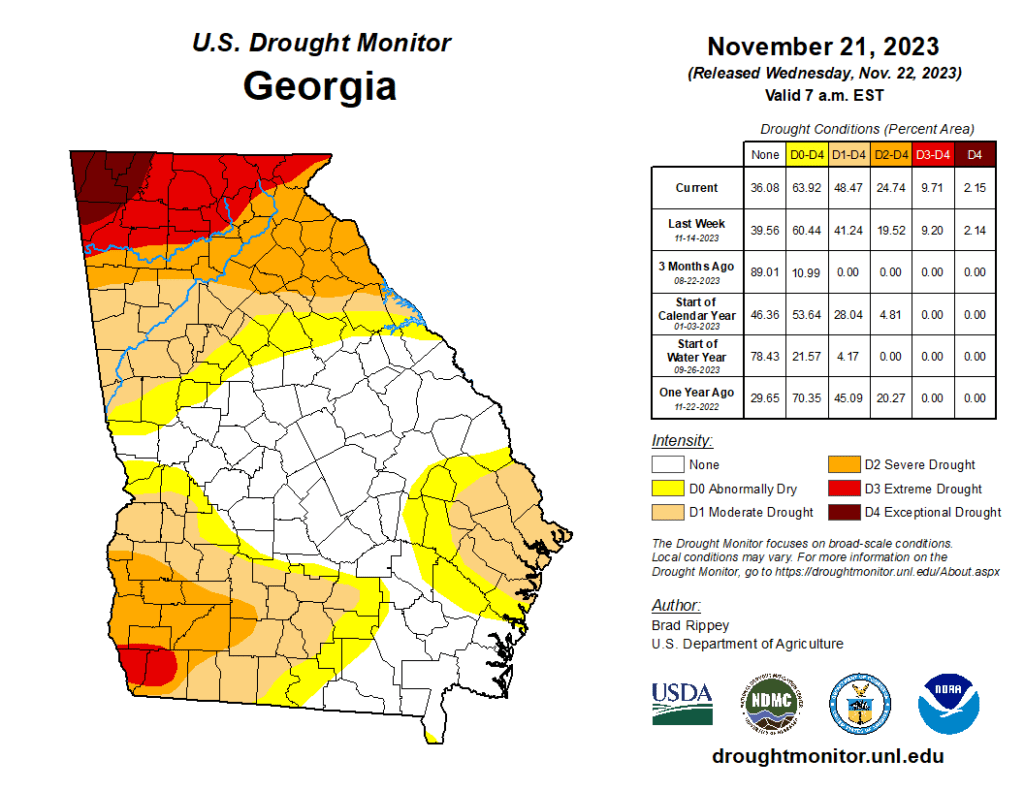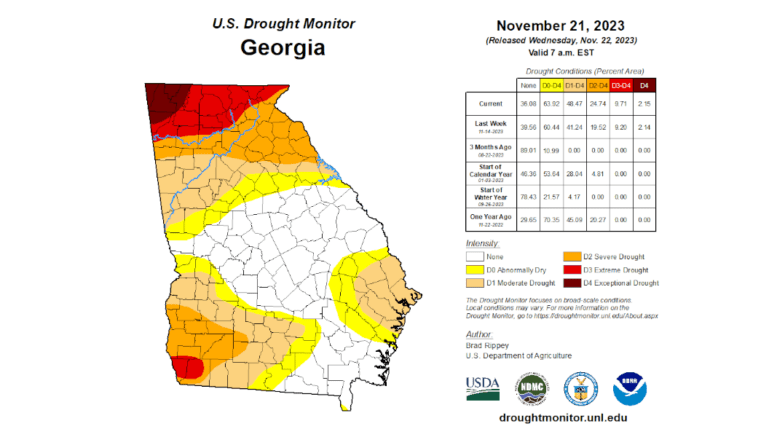The National Weather Service issued a high fire danger alert for Cobb County and other counties in the region for Thursday, November 30. This is the third day in a row that drought conditions and low relative humidity have created the conditions for the spread of fire in a large portion of west and central Georgia.
The U.S. Drought Monitor, updated yesterday, classifies conditions in the northern part of Cobb County as severe drought, and the remainder of the county as moderate drought. North of the county is even worse, with some counties classified as extreme, and the northwest corner of Georgia the driest category, “exceptional.”
The current weather forecast is for rain overnight, which might relieve the drought conditions.

The statement gives the following details:
…HIGH FIRE DANGER CONDITIONS THIS AFTERNOON INTO THE EVENING
FOR PARTS OF WEST AND CENTRAL GEORGIA DUE TO LOW RELATIVE
HUMIDITIES…
Relative Humidities of 30 percent or less can be expected for
4 or more hours this afternoon into the evening. Winds will be
southwest at 5 to 10 mph.
With dry fuels, high fire danger conditions can be expected.
Please refer to your local burn permitting authorities
whether you may burn outdoors. If you do burn outside,
use extreme caution.
Why does low relative humidity increase the danger of fire?
The National Park Service published the following explanation of why low relative humidity increases the danger of fires:
“Relative humidity is important because dead forest fuels and the air are always exchanging moisture. Low humidity takes moisture from the fuels, and fuels in turn, take moisture from the air when the humidity is high.
“Light fuels, such as grass and pine needles, gain and lose moisture quickly with changes in relative humidity. When the RH drops, fire behavior increases because these fine fuels become drier.
“Heavy fuels, on the other hand, respond to humidity changes more slowly. To see significant changes in heavy fuel moisture, there must be significant moisture, usually from more than a single storm.”
What counties are affected?
The following counties are included in the hazardous weather outlook:
Bartow, Bibb, Bleckley, Carroll, Catoosa, Chattahoochee, Chattooga, Cherokee, Clayton, Cobb, Coweta, Crawford, Crisp, Dade, DeKalb, Dodge, Dooly, Douglas, Fannin, Fayette, Floyd, Gilmer, Gordon, Haralson, Harris, Heard, Houston, Laurens, Macon, Marion, Meriwether, Murray, Muscogee, North Fulton, Paulding, Peach, Pickens, Pike, Polk, Pulaski, Schley, South Fulton, Spalding, Stewart, Sumter, Talbot, Taylor, Telfair, Troup, Twiggs, Upson, Walker, Webster, Wheeler, Whitfield, Wilcox, Wilkinson
What precautions should be taken?
The National Weather Service recommends extreme caution if you do outdoor burning during high fire danger conditions, and that you check your local fire ordinances.
>> To read a summary of Cobb County’s fire ordinances follow this link
About the National Weather Service
The National Weather Service (NWS) is a part of the National Oceanic and Atmospheric Administration (NOAA).
The NWS describes its role as follows:
“The National Weather Service (NWS) provides weather, water, and climate forecasts and warnings for the United States, its territories, adjacent waters and ocean areas, for the protection of life and property and the enhancement of the national economy.
“These services include Forecasts and Observations, Warnings, Impact-based Decision Support Services, and Education in an effort to build a Weather-Ready Nation.
“The ultimate goal is to have a society that is prepared for and responds to weather, water and climate events.”
Read all the Cobb County Courier climate and weather coverage by following this link.
